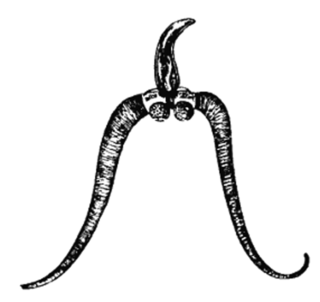Related Research Articles

Bucephalidae is a family of trematodes that parasitize fish. They lack suckers, having instead a muscular organ called a "rhynchus" at the front end which they use to attach to their hosts. The characteristics of the rhynchus are used to help define the genera of the family. It is one of the largest digenean families, with 25 genera containing hundreds of described species. Bucephalids are cosmopolitan, having been recorded all over the world. They are parasites of fish from freshwater, marine, and brackish water habitat types.

Opecoelidae is a family of trematodes. It is the largest digenean family with over 90 genera and nearly 900 species, almost solely found in marine and freshwater teleost fishes. It was considered by Bray et al. to belong in the superfamily Opecoeloidea Ozaki, 1925 or the Brachycladioidea Odhner, 1905.
Pseudopecoeloides is a genus of trematodes in the family Opecoelidae.

Hamacreadium is a genus of trematodes in the family Opecoelidae. It is synonymous with Olivacreadium Bilqees, 1976. Species of Hamacreadium are endoparasitic in fish such as Lethrinus Cuvier, 1829.
Allopodocotyle is a genus of trematodes in the family Opecoelidae.
Cainocreadium is a genus of trematodes in the family Opecoelidae. It has been synonymised with Apopodocotyle Pritchard, 1966, Cainocreadoides Nagaty, 1956, and Emmettrema Caballero y Caballero, 1946.
Coitocaecum is a genus of trematodes in the family Opecoelidae. It has been synonymised to Ozakia Wisniewski, 1934, Paradactylostomum Zhukov, 1972 nec Toman, 1992, and Pseudocoitocaecum Bilqees, 1972.
Dactylostomum is a genus of trematodes in the family Opecoelidae. It is synonyised with Opedunculata Dwivedi, 1975.
Decemtestis is a genus of trematodes in the family Opecoelidae. It has been synonymised with Allodecemtestis Hafeezullah, 1970.

Helicometra is a genus of trematodes in the class Opecoelidae. It is synonymous with AllostenoperaBaeva, 1968, MetahelicometraYamaguti, 1971, and StenoperaManter, 1933. Its type species is H. fasciata(Rudolphi, 1819). They are distinguished by their unique spiral uterus, from which their name is derived.
Helicometrina is a genus of trematodes in the family Opecoelidae.
Neohelicometra is a genus of trematodes in the family Opecoelidae. It consists of only one species, Neohelicometra scorpaenae Siddiqi & Cable, 1960.
Opecoeloides is a genus of trematodes in the family Opecoelidae. It has been synonymised with Cymbephallus Linton, 1934 and Fimbriatus von Wicklen, 1946.
Opecoelus is a genus of trematodes in the family Opecoelidae.
Opegaster is a genus of trematodes in the family Opecoelidae.
Peracreadium is a genus of trematodes in the family Opecoelidae. It is very similar to the related genus Cainocreadium Nicoll, 1909, and has been synonymised with the genera Anabathycreadium Salman & Srivastava, 1990, Indocreadium Salman & Srivastava, 1990, and Lebouria Nicoll, 1909.
Pseudopecoelus is a genus of trematodes in the family Opecoelidae. It has been synonymised with Neopecoelus Manter, 1947.
Heterolebes is a genus of trematodes in the family Opecoelidae.
Maculifer is a genus of trematodes in the family Opecoelidae.
Pseudoheterolebes is a genus of trematodes in the family Opecoelidae. After having been originally described, it was largely ignored by other scientists due to the originally vague definition of the genus; Martin et al., 2018 resurrected the genus to resolve a dispute among the existing definitions of Opistholebes and Maculifer, which were also described by earlier reports of Yamaguti.
References
- 1 2 Nicoll, W. (1915). The trematode parasites of north Queensland. III. Parasites of fishes. Parasitology, 8, 24–41.
- ↑ Manter, H. W. (1947). The digenetic trematodes of Tortugas, Florida. American Midland Naturalist, 38(2), 257–416.
- ↑ Ozaki, Y. (1935). Two new trematodes of the family Opistholebetidae Travassos. Proceedings of the Imperial Academy, 11, 244–246.
- ↑ Cable, R. M. (1956). Opistholebes diodontis n. sp., its development in the final host, the affinities of some amphistomatous trematodes from marine fishes, and the allocreadioid problem. Parasitology, 46, 1–13.
- ↑ Liu, S. F. (1999). Description of three new species of Opistholebetidae (Trematoda: Digenea). Acta Zootaxonomica Sinica, 24, 265–271.
- ↑ Ozaki, Y. (1937). Studies on the trematode families Gyliauohenidae and Opistholebetidae, with special reference to lymph system. Journal of Science of the Hiroshima University, Zoology, 5, 125–244.
- ↑ Bilqees, F. & Nighat, Y. (1982). Two species of the genus Opistholebes Nicoll, 1915 from the fish Diodon hystrix of Karachi coast (Trematoda: Opistholebetidae). Pakistan Journal of Zoology, 14(1), 33–37.
- 1 2 Gupta, A. N. (1968). On three new species of Opistholebes (Opistholebetidae Fukui, 1929) from the globe fish, Tetraodon viridipunctatus (Gunther) from India. Journal of Helminthology, 42(3–4), 283–288.
- ↑ Ku, C. T. & Shen, J. W. (1965). Studies on some digenetic trematodes from marine fishes in China. Acta Parasitologica Sinica, 2, 355–365.
| | This Trematoda (fluke)- related article is a stub. You can help Wikipedia by expanding it. |